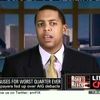
My grandfather used to tell me a story of a horse being ridden by his master who begins to ride into a dark tunnel when the horse stops and refuses to go into the pitch black tunnel. The master takes out his handkerchief, blindfolds the horse and they ride into the tunnel when suddenly the master sees a huge hole. Going at such a fast speed the master knew it was impossible to stop the horse. Thinking quickly, the master jumped off just in time to safety. Meanwhile, the horse fell to his death to the bottom of the hole. Whose fault is it that the horse died?
Without the basic knowledge of how to control our finances, without being equipped or supplied with an ability to think for ourselves, we are no better off than that horse being led into a dark tunnel blindfolded.
Consider too that the estimated loss to the company retirement plans belonging to Enron employees was $1.2 billion. If Enron employees had received proper financial literacy education, they would have known about diversification and would have appropriately limited the amount of company stock held within their company retirement plans. Many employees had as high as 80-90% of their retirement portfolio invested in Enron stock. With defined contribution plans becoming more of the norm (as opposed to defined benefit plans); employees are now burdened with the responsibility of planning for their own retirement.
If any one stock comprises over 25% of your total holdings in your company portfolio I would like to outline a few solutions for you. These are listed below:
1. A Partial or Complete Sale of the Position:
a. The Outright Sale : The simplest solution of all is to sell some of all of your position of the company stock. However you need to be mindful of the capital gains tax liability that is associated with this solution.
b. The Installment Sale : This sale will result in income tax consequences during the executive's lifetime. One should also consult a qualified estate planner who will be able to inform them of the potentially disadvantageous estate tax consequences should the executive pass away during the term of the installment contract. These consequences can be eliminated by executing a self-canceling installment note (SCIN); however, the implementation of the (SCIN) will result in additional income tax liability results to the executive's estate which should also be discussed with a qualified estate planner.
c. Private Annuity: One can enter into a private annuity with a family member or a trusted individual. The obligor of the annuity must be trusted to be able to make good on the annuity payments that are due to the annuitant as this contract may not be collateralized with the underlying employer stock.
2. A Partial or Complete Gift of the Position
Gifts are excluded from the definition of gross income so this does avoid the income tax consequences associated with a sale of company stock. In executing this, one must consult the assistance of a tax advisor as gifting stock to others may result in the imposition of state taxes as well as federal taxes.
3. Hedging the Position with Options
In the case of Enron, one could have purchased put options which allow the employee to take an offsetting short position to the established long position generated by owning the company stock.
4. Using Variable Prepaid Forward Contracts
Within this option, one agrees to sell a variable number of shares at some point in the future in return for receiving an upfront cash advance. The employee can use this capital to reposition these funds to work in a more diversified portfolio. Under this solution taxes are deferred until the contract's expiration. Upon expiration the employee will be obligated to pay capital gains taxes on the difference between the proceeds from the cash advance and his or her cost basis in the employer shares.
5. Using a Charitable Remainder Trust (CRT)
If one establishes a CRT and assets are transferred to its trustee, an income tax deduction is given that may be used to offset current taxable income. A qualified estate planner should be consulted before using this option.
6. Using an Exchange Fund
Many companies offer exchange funds that may be used in the management of a concentrated portfolio. If you are an employee you will be able to contribute the shares of your publicly traded stock to the fund. The employee will receive a percentage income interest from the overall fund. The fund is tax free for income purposes and the fund owns numerous securities other than the company stock so the employee now receives interest from a diversified fund. Be mindful of the lack of liquidity as investors may be required to be invested for 7 years to avoid incurring an income tax liability. Furthermore, federal income tax law mandates that 20% of the asset in the fund be invested in illiquid assets such as real estate.
In 1986 there was a study conducted in the Financial Analyst Journal by Gary P. Brinson, L. Rudolph Hood, and Gilbert L. Beebower, otherwise known as the (first) "Brinson Study". After analyzing over 90 corporate portfolios for almost 10 years, they concluded that over 93% of variation in the actual portfolio ending performance could be traced to asset allocation. A separate study by the same organization was conducted in 1991 which supported the original findings proving that asset allocation was the single most important factor in determining actual portfolio performance over an extended period of time. In short, asset allocation and its impact on establishing an efficient, well-diversified portfolio should not be taken lightly. Enron did not have to happen. We must make sure that we are doing the right things and taking the proper measures to make sure it does not happen again within our company retirement plans.
